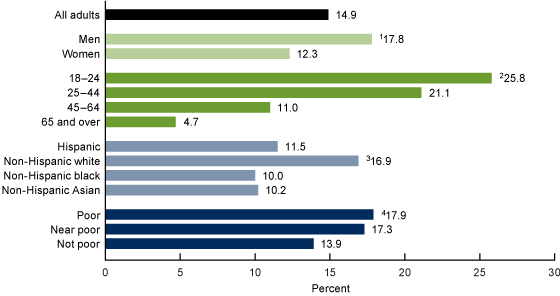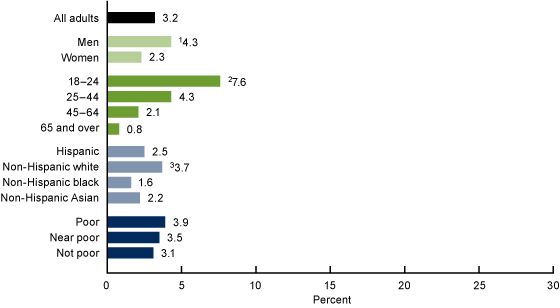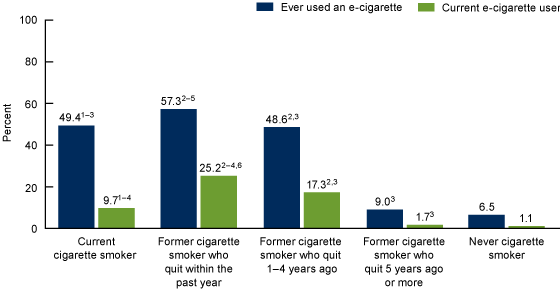Electronic Cigarette Use Among U.S. Adults, 2018
- Key findings
- The percentage of adults who had ever used an e-cigarette varied by sociodemographic characteristics.
- The percentage of adults who were current e-cigarette users varied by sociodemographic characteristics.
- The percentages of adults who had ever used an e-cigarette and those who were current e-cigarette users varied by cigarette smoking status.
- Summary
- Definitions
- Data source and methods
- References
- Suggested citation
NCHS Data Brief No. 365, April 2020
PDF Versionpdf icon (433 KB)
Key findings
Data from the National Health Interview Survey
- In 2018, 14.9% of adults had ever used an electronic cigarette (e-cigarette), and 3.2% were current e-cigarette users.
- The prevalence of adults who had ever used an e-cigarette and were current users was highest among men, non-Hispanic white adults, and those aged 18–24.
- Comparing by cigarette smoking status, adults who quit smoking cigarettes within the past year were the most likely to have ever used (57.3%) and to be current (25.2%) e-cigarette users.
In 2018, an estimated 8.1 million U.S. adults were current electronic cigarette (e-cigarette) users (1). E-cigarette use is a public health concern (2), and it has been linked to a recent outbreak of lung injury and deaths among adults (3). Although the potential long-term health risks of e-cigarettes are not yet as well-known as they are with cigarettes, e-cigarettes usually contain nicotine, and nicotine is highly addictive (2). Moreover, the most common tobacco product combination among adults is e-cigarettes and cigarettes (4). This report examines e-cigarette use among U.S. adults aged 18 and over by selected sociodemographic characteristics and in relation to cigarette smoking status.
Keywords: vaping, e-cigarette, tobacco, National Health Interview Survey
The percentage of adults who had ever used an e-cigarette varied by sociodemographic characteristics.
- In 2018, 14.9% of adults had ever used an e-cigarette (Figure 1).
- Men (17.8%) were more likely than women (12.3%) to have ever used an e-cigarette.
- The percentage of adults who had ever used an e-cigarette decreased as age and income increased.
- Non-Hispanic white adults (16.9%) were more likely than Hispanic (11.5%), non-Hispanic black (10.0%), and non-Hispanic Asian (10.2%) adults to have ever used an e-cigarette.
Figure 1. Percentage of adults who had ever used an e-cigarette, by sex, age, race and Hispanic origin, and poverty status: United States, 2018
1Significantly different from women (p < 0.05).
2Significant linear trend by age (p < 0.05).
3Significantly different from Hispanic, non-Hispanic black, and non-Hispanic Asian adults (p < 0.05).
4Significant linear trend by poverty status (p < 0.05).
NOTES: Adults were considered poor if their family income fell below 100% of the federal poverty level (FPL), near poor if their family income fell at or above 100% but below 200% of the FPL, and not poor if their family income fell at or above 200% of the FPL. Estimates are based on household interviews of a sample of the civilian noninstitutionalized U.S. population. Access data table for Figure 1pdf icon.
SOURCE: NCHS, National Health Interview Survey, 2018.
The percentage of adults who were current e-cigarette users varied by sociodemographic characteristics.
- In 2018, 3.2% of adults were current e-cigarette users (Figure 2).
- Men (4.3%) were almost twice as likely as women (2.3%) to be current e-cigarette users.
- The percentage of adults who were current e-cigarette users decreased with age, from 7.6% among those aged 18–24, 4.3% among those aged 25–44, 2.1% among those 45–64, to 0.8% among those aged 65 and over.
- Non-Hispanic white adults (3.7%) were more likely than Hispanic (2.5%), non-Hispanic black (1.6%), and non-Hispanic Asian (2.2%) adults to be current e-cigarette users.
- Differences in current e-cigarette use by income were not significant.
Figure 2. Percentage of adults who were current e-cigarette users, by sex, age, race and Hispanic origin, and poverty status: United States, 2018
1Significantly different from women (p < 0.05).
2Significant quadratic trend by age (p < 0.05).
3Significantly different from Hispanic, non-Hispanic black, and non-Hispanic Asian adults (p < 0.05).
NOTES: Adults were considered poor if their family income fell below 100% of the federal poverty level (FPL), near poor if their family income fell at or above 100% but below 200% of the FPL, and not poor if their family income fell at or above 200% of the FPL. Estimates are based on household interviews of a sample of the civilian noninstitutionalized U.S. population. Access data table for Figure 2pdf icon.
SOURCE: NCHS, National Health Interview Survey, 2018.
The percentages of adults who had ever used an e-cigarette and those who were current e-cigarette users varied by cigarette smoking status.
- The percentage of adults who had ever used an e-cigarette (57.3%) and the percentage of adults who were current e-cigarette users (25.2%) was highest among former cigarette smokers who quit within the past year (Figure 3). The percentage of adults who had ever used an e-cigarette or who were current e-cigarette users declined with a longer duration of quitting cigarettes among former smokers.
- The percentage of adults who had ever used an e-cigarette or who were current e-cigarette users was lowest among those who never smoked cigarettes (6.5% and 1.1%, respectively).
- The percentage of adults who were current e-cigarette users was lower for current cigarette smokers (9.7%) than for former cigarette smokers who quit within the past year (25.2%) and former cigarette users who quit 1–4 years ago (17.3%).
Figure 3. Percentage of adults who had ever used an e-cigarette and were current e-cigarette users, by cigarette smoking status: United States, 2018
1Significantly different from former cigarette smokers who quit within the past year (p < 0.05).
2Significantly different from former cigarette smokers who quit 5 years ago or more (p < 0.05).
3Significantly different from never smokers (p < 0.05).
4Significantly different from former cigarette smokers who quit 1–4 years ago (p < 0.05).
5Significant quadratic trend by duration of quitting cigarette smoking among former smokers (p < 0.05).
6Significant linear trend by duration of quitting cigarette smoking among former smokers (p < 0.05).
NOTES: Estimates are based on household interviews of a sample of the civilian noninstitutionalized U.S. population. Access data table for Figure 3pdf icon.
SOURCE: NCHS, National Health Interview Survey, 2018.
Summary
In 2018, 14.9% of adults aged 18 and over had ever used an e-cigarette, and 3.2% of adults were current e-cigarette users. Those who had ever used an e-cigarette and those who were current users were more likely to be men compared with women, aged 18–24 compared with older ages, and non-Hispanic white adults compared with Hispanic, non-Hispanic black, or non-Hispanic Asian adults. The percentage of adults who had ever used an e-cigarette was highest among those who were poor, and decreased as income increased.
In 2018, 34 million U.S. adults were current smokers, and 55 million were former cigarette smokers for any duration (5). E-cigarette use was highest among current smokers and former smokers who quit cigarettes within the past year and those who quit 1–4 years ago. The percentages who had ever used an e-cigarette or who were current e-cigarette users declined among former smokers who had gone longer without smoking cigarettes and was lowest among those who never smoked cigarettes.
Definitions
E-cigarette use: “Ever used an e-cigarette” was based on a positive response to the survey question, “Have you ever used an e-cigarette, even one time?” Respondents were categorized as “Current e-cigarette users” based on the responses “every day” or “some days” to a follow-up question that asked, “Do you now use e-cigarettes every day, some days, or not at all?”
Cigarette smoking status: Based on the survey question, “Have you smoked at least 100 cigarettes in your entire life?” and a follow-up question that asked, “Do you now smoke cigarettes every day, some days, or not at all?” Adults who smoked every day or some days were classified as “current cigarette smokers.” For those who do not smoke at all, a follow-up question asked, “How long has it been since you quit smoking?” These former cigarette smokers were classified into “quit within the past year,” “quit 1–4 years ago,” and “quit 5 years ago or more.” Adults who had not smoked 100 cigarettes in their lifetime were classified as “never smokers.”
Race and Hispanic origin: Based on responses to two questions that determine Hispanic or Latino origin and race. Persons of Hispanic or Latino origin may be of any race. Non-Hispanic white, non-Hispanic black, and non-Hispanic Asian refer to persons with a single race group.
Poverty status: Categories were based on the ratio of a family’s income in the previous calendar year to the appropriate poverty threshold (given the family’s size and number of children), as defined by the U.S. Census Bureau. The 2018 National Health Interview Survey (NHIS) imputed income files were used to allow for imputed values when family income was not provided. Adults were considered poor if their family income fell below 100% of the federal poverty level (FPL), near poor if their family income fell at or above 100% but below 200% of the FPL, and not poor if their family income fell at or above 200% of the FPL.
Data source and methods
Data from the 2018 NHIS were used for this analysis. NHIS is a nationally representative, household survey of the civilian noninstitutionalized U.S. population. It is conducted continuously throughout the year by the National Center for Health Statistics (NCHS). Questions about e-cigarette use were introduced in the 2014 NHIS (6). Data for this analysis come from the Family and Sample Adult components of NHIS. For more information about NHIS, visit its website at: https://www.cdc.gov/nchs/nhis.htm.
Point estimates and the corresponding variances were calculated using SAS-callable SUDAAN version 11.0 (RTI International, Research Triangle Park, N.C.) to account for the complex sample design of NHIS. Linear and quadratic trends by age and poverty status were evaluated using the POLY function in SUDAAN’s PROC DESCRIPT. Trends and differences between percentages were evaluated using two-sided significance tests at the 0.05 level. All estimates presented meet NCHS data presentation standards for proportions (7).
References
- Creamer MR, Wang TW, Babb S, Cullen KA, Day H, Willis G, et al. Tobacco product use and cessation indicators among adults—United States, 2018external icon. MMWR Morb Mortal Wkly Rep 68(45):1013–19. 2019.
- National Center for Chronic Disease Prevention and Health Promotion. E-cigarette use among youth and young adults. A report of the Surgeon Generalpdf iconexternal icon. 2016.
- National Center for Chronic Disease Prevention and Health Promotion. Outbreak of lung injury associated with the use e-cigarette, or vaping, products.
- Wang TW, Asman K, Gentzke AS, Cullen KA, Holder-Hayes E, Reyes-Guzman C, et al. Tobacco product use among adults—United States, 2017. MMWR Morb Mortal Wkly Rep 67(44):1225–32. 2018.
- Villarroel MA, Blackwell DL, Jen A. Tables of summary health statistics for U.S. adults: 2018 National Health Interview Surveypdf icon. National Center for Health Statistics. 2019.
- Schoenborn CA, Gindi RM. Electronic cigarette use among adults: United States, 2014pdf icon. NCHS Data Brief, no 217. Hyattsville, MD: National Center for Health Statistics. 2015.
- Parker JD, Talih M, Malec DJ, Beresovsky V, Carroll M, Gonzalez Jr. JF, et al. National Center for Health Statistics data presentation standards for proportionspdf icon. National Center for Health Statistics. Vital Health Stat 2(175). 2017.
Suggested citation
Villarroel MA, Cha AE, Vahratian A. Electronic cigarette use among U.S. adults, 2018. NCHS Data Brief, no 365. Hyattsville, MD: National Center for Health Statistics. 2020.
Copyright information
All material appearing in this report is in the public domain and may be reproduced or copied without permission; citation as to source, however, is appreciated.
National Center for Health Statistics
Jennifer H. Madans, Ph.D., Acting Director
Amy M. Branum, Ph.D., Acting Associate Director for Science
Division of Health Interview Statistics
Stephen J. Blumberg, Ph.D., Director
Anjel Vahratian, Ph.D., M.P.H., Associate Director for Science


